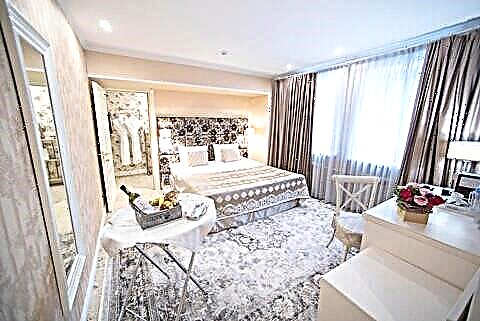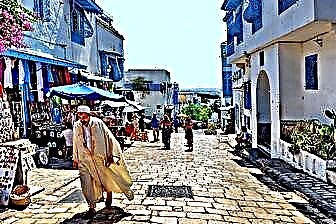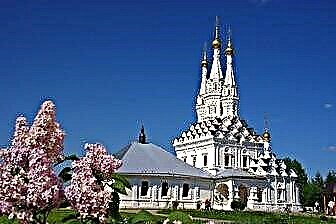Address: Russia, Moscow, Vorontsovsky Park (metro stations Prospekt Vernadsky and Novye Cheryomushki)
Main attractions: Guardhouses with towers, northern wings, the Church of the Life-Giving Trinity, Big Voronovsky Pond
Coordinates: 55 ° 39'59.6 "N 37 ° 31'53.8" E
Cultural heritage site of the Russian Federation
Content:
In the south-west of Moscow there is an estate, known since the XIV century. Throughout its history, Vorontsovo has experienced periods of decline and prosperity. The estate was badly ravaged during the Time of Troubles and during the Patriotic War of 1812, however, every time the caring owners rebuilt it anew. Vorontsovo remained in history as a place where in 1812 they tried to build a secret weapon against Napoleon's troops - the first Russian balloon.

View of the humpback bridge and guardhouses with towers
What was the estate in the XIV-XVIII centuries
In the XIV century, the lands where the estate was later rebuilt belonged to the wife of the great Moscow prince Vasily - Sophia. They were part of a vast princely estate, the center of which was the village of Vorobyevo near Moscow, standing on the Vorobyovy Hills. According to the surviving documents, it is known that the eminent boyar Fyodor Vasilyevich Voronets became the first owner of the estate located to the south-west of Moscow. By his last name, the village began to be called "Vorontsovskoe", and later - "Vorontsovo".
In the middle of the 15th century, Prince Yuri Vasilyevich Dmitrovsky, the grandson of Princess Sophia, took possession of the estate. For another two centuries, the estate passed from one royal relative to another. At the beginning of the 17th century, in the Time of Troubles, Vorontsovo was ravaged and became a wasteland. During this difficult period of Russian history, most of the estates and villages near Moscow looked exactly the same.
Changes in the life of the estate came during the reign of Tsar Mikhail Fedorovich. The settlement was presented to the Tsar's favorite - Prince Boris Alexandrovich Repnin. He made a dizzying career at the court, and from the stewards was raised by the sovereign right in the boyar. Repnin was handed over to Vorontsovo as a patrimony, that is, it became his permanent property.

The main gate of the estate
Since the 17th century, the first buildings appeared on the estate, which determined its appearance. Repnin built a stone manor house, outbuildings and a luxurious "Gothic" entrance to the estate. According to one version, one of the most famous Russian portrait painters Fyodor Stepanovich Rokotov (1735-1808) was born in Vorontsovo. In his youth, the famous artist was a serf of the owner of the estate, Peter Ivanovich Repnin.
Construction of a military balloon in Vorontsovo
At the beginning of the 19th century, Vorontsovo began to belong to the Repnins' successor, Alexandra Nikolaevna Volkonskaya. In the spring of 1812, she leased the estate to the civil governor of Moscow N.V. Obrezkov. One of the most unusual pages in the history of the Vorontsov estate is associated with it.
In early 1812, an inventor from Germany, Franz Leppich, came to Napoleon with the idea of building a controlled balloon. However, Bonaparte did not support him and expelled him from the country. Without hesitation, Leppich turned with his plan to the Russian tsar Alexander I. The possible attack by Napoleon on Russia was no secret to anyone, and the Russian tsar made every effort to find effective means to resist the French army.
The idea of building a balloon that could lift up to 40 soldiers and about five tons of boxes filled with gunpowder into the air was extremely interested in the sovereign. He instructed Obrezkov to place Leppich and his assistants near Moscow and begin the secret manufacture of weapons against Bonaparte. Vorontsovo was chosen as the construction site for the future "flying ship".

Church of the Life-Giving Trinity on the territory of the estate
So that no one would find out about the secret balloon, the work in the estate was called either "a factory for the preparation of cannon charges", or "an enterprise for the manufacture of land machines." For the purchase of iron filings and sulfuric acid necessary for the production of hydrogen, the treasury allocated fantastic money at that time - 100 thousand rubles.
The balloon was made by about 150 workers - blacksmiths, mechanics, seamstresses and carpenters. The classified production was visited by Tsar Alexander I. By the beginning of July, Napoleon's troops were already attacking Russia, but the balloon was not yet ready.
When Bonaparte approached Moscow, the evacuation began. Leppikh's enterprise was loaded onto 150 carts and transported to Nizhny Novgorod, and the parts remaining in Vorontsovo and the body of the "air gondola" were burned. In 1813, the inventor continued building a balloon, first in Nizhny Novgorod, and then in St. Petersburg, but he never managed to lift his brainchild into the sky.
History of the estate in the XIX-XX centuries
Napoleon's troops plundered the estate. The French destroyed the art gallery kept here and part of the buildings. But in the 20s of the XIX century Vorontsovo was restored. At this time, the estate was owned by Princess Zinaida Alexandrovna Volkonskaya. She was a famous writer and hostess of a popular secular salon, which was visited by many celebrities.
In 1837, Sergei Mukhanov became the owner of Vorontsovo. Under him, the manor park was reconstructed and an orchard was laid. In addition, many new buildings have appeared on the estate.

Northern wings
Until the beginning of the 20th century, Vorontsovo was replaced by several owners. In 1911, the estate became the property of the attorney at law Yevgeny Adamovich Grünbaum. He built a greenhouse, premises for workers, an office, a kitchen and a brick factory in the new ownership. Many manor houses began to be rented out to rich Muscovites for summer cottages.
In 1918, the new authorities began to use Vorontsovo to house the state farm. The furnishings of the manor house and dachas were plundered, and the Red Army men settled on the territory of Vorontsovo. After the Great Patriotic War, a biological station was kept here. The estate received the status of a monument of gardening art only in 1979.
What can be seen in Vorontsovo today
Today the state-protected manor and park territory occupies 40.7 hectares. Its most important part is a cascade of five ponds dug in the 18th century on a tributary of the Ramenka River.
In the mid-2000s, all Vorontsov's ponds were drained and thoroughly cleaned out. Workers have fortified the coastline and restored near-water plants. So nowadays artificial reservoirs greet guests of Vorontsovo with renewed ones. At any time of the year on their shores you can meet people who like to fish, and in summer everyone can go boating on the large pond.

Big Voronovsky pond
The farmstead has long become a favorite vacation spot for residents of nearby neighborhoods. About half of its territory is overgrown with shrubs and trees. Other species are dominated by oak and linden. Most of the local oak trees have grown naturally, and in the park you can see many trees that are over 110-120 years old. In the north of the estate, rows are visible in oak groves. These are traces of plantings that were made on the estate in the 19th century. At the entrance to the estate from the side of Akademika Pilyugin Street, two oak trees have survived, which are more than 250 years old.
A lot of hazel grows in the undergrowth of the old park, and nimble squirrels constantly feast on nuts. Birds have found shelter in the dense crowns of trees. Visitors to the park love to feed birds and squirrels, and they constantly hang feeders around the territory.
Some of the manor buildings in Vorontsovo have been well restored. Among them, a special place is occupied by the pink and white northern service wing (or greenhouse). The one-storey building in the classical style was erected by the Vokonsky-Repnins after the plundering of the estate by Napoleon's troops.
In Vorontsovsky Park there is a temple consecrated in honor of the Life-Giving Trinity. It appeared here in 1807 from a converted park pavilion. In 1812, the French who visited Vorontsovo desecrated the church, so the owners of the estate had to restore it and consecrate it anew.

Voronovsky park
In 1838 Vorontsov's church was reconstructed. The builders rebuilt the bell tower and erected a new warm side-chapel in honor of Sergius of Radonezh. A century later, during the anti-religious campaign, which was carried out by the Soviet government, the church was closed, and inside were workshops, a warehouse, a store, and then a toy factory. The shrine was restored in the 1990s, thanks to the efforts of the parishioners.
There is a worship cross not far from the temple. It was erected in honor of the residents of the southwestern districts of the capital, who gave their lives, eliminating the consequences of the Chernobyl accident. In 2004, an obelisk was erected in the central part of the park, which is dedicated to the soldiers-defenders of the Russian land. It is erected in memory of all the owners of the estate, who gave their debt to the Fatherland on the battlefield.
Vorontsovo for recreation and entertainment
The estate has several playgrounds for children of different ages. In addition, the Alley of Games amusement park is open here on weekdays from 12.00 to 19.00, and on Saturdays and Sundays from 11.00 to 20.00. In the northwest of the estate, you can visit the green labyrinths, which were extremely popular in the parks of the 18th century.
To the east of the third pond, there is a stylized corner - the Chinese Garden. It is a small, Chinese-style landscape park. And between the large pond and the eastern wing there is a chess pavilion, where you can always meet lovers of the ancient game bending over the boards.

Chinese garden
The main entrances to the park area are open daily from 8.00 to 22.00. At other times, people enter the estate through the gates located along its perimeter. It is allowed to move around the park on foot or by bicycle. The entry of vehicles into Vorontsovo is prohibited.
How to get there
From the stations of the Moscow metro "Prospekt Vernadsky" and "Novye Cheryomushki" you can get to the estate by buses (stop "Vorontsovsky Park"). It is convenient to walk to the territory of the estate from the Kaluzhskaya station. This journey takes about 15 minutes.











